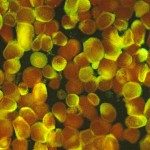Lien vers Pubmed [PMID] – 12825185
J. Infect. Dis. 2003 Jul;188(1):153-64
Maternal malaria is associated with the sequestration, in the placenta, of Plasmodium falciparum-infected erythrocytes onto chondroitin sulfate A (CSA), via the duffy binding-like (DBL)-gamma3 domain of the P. falciparum erythrocyte membrane protein 1 (PfEMP1(CSA)) (DBL-gamma3(CSA)). The production of antibodies against CSA-binding infected erythrocytes (IEs(CSA)) is correlated with resistance to maternal malaria in multiparous women. We produced recombinant DBL-gamma3(CSA) (rDBL-gamma3(CSA)) in insect cells, corresponding to 2 variant DBL-gamma3(CSA) subtypes that mediate binding to CSA in laboratory lines and placental isolates. Both recombinant cysteine-rich DBL-gamma3(CSA) domains blocked IEs(CSA) binding to CSA. Immunization of mice, with the rDBL-gamma3(CSA)-FCR3 and rDBL-gamma3(CSA)-3D7 domains, resulted in the generation of antibodies recognizing homologous and heterologous rDBL-gamma3(CSA), a finding indicating conserved epitopes inducing a pan-reactive immune response. Mouse monoclonal antibodies (MAbs) against both recombinant proteins were pan-reactive with various IEs(CSA). One MAb efficiently inhibited and reversed IE(CSA) cytoadhesion to endothelial cells in vitro. Thus, DBL-gamma3(CSA) is the target of inhibitory and pan-reactive antibodies. Saimiri sciureus monkeys immunized with FCR3-rDBL-gamma3(CSA) developed pan-reactive and inhibitory antibodies, a finding suggesting that the development of a vaccine to prevent maternal malaria is feasible.

